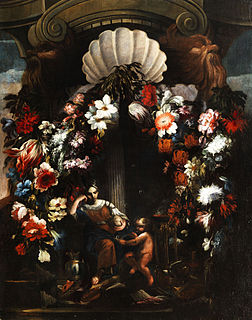Related Research Articles

Ottavio Leoni (1578–1630) was an Italian painter and printmaker of the early-Baroque, active mainly in Rome.
Bonaventura Lamberti was an Italian painter of the Baroque period, active mainly in Rome. He was born at Carpi, and after some years working at Modena, he became a pupil of the painter Carlo Cignani in Rome. There, he became attached to the household of the Marchese Gabrieli. In Rome, he painted St. Francis of Paola resuscitating a dead Child for the church of the Spirito Santo de Napolitani. He painted some cartoons used for mosaics for St. Peter's basilica by Ottaviani. His Virgin showing the Infant Saviour to St. Jerome was engraved by Ludovico Dorigny. Among those who worked with him was Marco Benefial. He died at Rome.
Mario Labacco was an Italian engraver of the Renaissance period, active in Rome.

Giuseppe Laudati was an Italian painter of the Baroque period.
Giacomo Lauri (1623–1694) was an Italian engraver of the Baroque period, active mainly in his native Rome.
Pedro Pozo was a Spanish historical painter. He was born at Lucena. He first studied under Luis Cancino, and afterwards went to Rome. He eventually abandoned painting for literature. His son, also Pedro and an artist, died in America.

Giulio Mazzoni (1525–1618) was an Italian painter and stuccoist, active during the Renaissance period. He was born in Piacenza, but studied in Rome under Daniele da Volterra, and was active about the year 1568. He helped decorate the Palazzo Spada. He also painted a canvas of the Four Evangelists for the Cathedral of Piacenza.
Pietro Lucatelli was an Italian painter active during the Baroque period in Rome. He was born near Rome. He was a pupil of Ciro Ferri and Pietro da Cortona, and his pictures in the church of Sant' Agostino and the Palazzo Colonna show boldness and freedom of coloring. At Siena he painted a Beato Galgano for the church of San Francesco, and an Assumption for the hospital of Santa Maria della Scala. He was living in 1690, and died destitute and poor in Rome.

Gasparo Lopez was an Italian painter of the Baroque period.
Orazio de Santis, also known as L'Aquilano, was an Italian engraver of the Renaissance period. He was probably born in L'Aquila. He made prints based on designs of Pompeo Aquilano. He also produced 74 plates of antique statues in Rome, the joint work of Santis and Cherubino Alberti, published in 1584.
Francesco Terzi was an Italian painter of the Renaissance period. He was born in Bergamo. He was a pupil of Giovanni Battista Moroni. He painted two pictures a Nativity, and an Assumption of the Virgin for San Francesco, in Bergamo. He was invited and appointed painter to the court of the Emperor Maximilian II in Vienna. Terzi passed the greater part of his life in Germany, but died in Rome. A series of portraits by him of the Austrian archducal family was afterwards engraved. Francesco Lana de Terzi was a visionary Jesuit writer and engineer.
Bartolommeo Tutiani was an Italian engraver on wood of the Renaissance period. He completed an engraving of Christ insulted by the Jews, printed in Augsburg in 1515.
Camillo Tinti was an Italian engraver, born in Rome. He was employed by Gavin Hamilton to engrave some of the plates for his Schola Itálica; among these were the following: The Marriage of St. Catherine after Parmigianino; Meleager and Atalanta after Polidoro da Caravaggio; and Christ on the Mount of Olives after Giovanni Lanfranco.

Giuseppe Niccolò Vicentino, called Rospigliosi, was an Italian painter and wood-engraver of the Renaissance. He was born at Vicenza c. 1510, and worked at Bologna about 1540. His method was chiaroscuro. He used three blocks, and did much to develop the process. Among other cuts by him are: A Sibyl reading a Book; Hercules killing the Nemaean Lion after Raphael; Death of Ajax after Polidoro da Caravaggio; Venue embracing Cupid; and Glelia escaping from Porsenna's camp.
Urbano Romanelli was an Italian painter of the Baroque period.
Adriano Zabarelli, also known as Andrea Palladino or il Palladino was an Italian painter of the Baroque period. He was born and active in Cortona, although he was a pupil of Pietro da Cortona in Rome.

Bernardino Parasole was an Italian painter of the Baroque period.

Isabella Parasole was an Italian engraver and woodcutter of the late-Mannerist and early-Baroque periods.
Pietro Nelli was an Italian painter of the late-Baroque period.
Nicolaus van Aelst was a Flemish engraver and perhaps painter, and a resident of Rome.
References
- ↑ Bryan, Michael (1889). Dictionary of Painters and Engravers: Biographical and Critical. G. Bell and sons.
- ↑ Witcombe, Christopher L. C. E. (2004-01-01). Copyright in the Renaissance: Prints and the Privilegio in Sixteenth-Century Venice and Rome. BRILL. ISBN 978-90-04-13748-6.
- Bryan, Michael (1889). Walter Armstrong; Robert Edmund Graves (eds.). Dictionary of Painters and Engravers, Biographical and Critical. Vol. II L-Z. London: George Bell and Sons. p. 251.